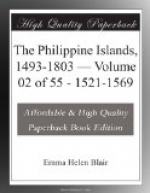but the project was defeated by Fernando’s death
(January 23, 1516). In the same year Cabot led
an English expedition which coasted. Labrador
and entered Hudson Strait; he then returned to Spain,
and was appointed (February 5, 1518) royal pilot-major,
an office of great importance and authority. He
was one of the Spanish commissioners at Badajoz in
1524; and in 1526 commanded a Spanish expedition to
the Moluccas, which sailed from Spain on April 3 of
that year. Arriving at the River de la Plata,
Cabot decided to explore that region instead of proceeding
to the Moluccas—induced to take this step
by a mutiny among his officers, sickness among his
crews, and the loss of his flag-ship. Misfortunes
followed him, and he returned to Spain in 1530.
Upon the accession of Edward VI to the English throne,
Cabot was induced to reenter the English service,
which he did in 1548, receiving from Edward promotion
and rewards. Nothing is heard of him after 1557;
and no work of his is known to be extant save a map
of the world, made in 1544. and preserved in the Bibliotheque
Nationale, Paris. Regarding his life and achievements,
see Nicholls’s
Sebastian Cabot (London,
1869); Henry Stevens’s
Sebastian Cabot
(Boston, 1870); Harrisse’s
Jean et Sebastian
Cabot (Paris, 1882); F. Tarducci’s
John
and Sebastian Cabot (Brownson’s translation,
Detroit, 1893); Dawson’s “Voyages of the
Cabots,” in
Canad. Roy. Soc.
Trans., 1894, pp. 51-112, 1896, pp. 3-30, 1897,
pp. 139-268; Dionne’s
John and Sebastian Cabot
(Quebec, 1898); Winship’s
Cabot Bibliography
(London, 1900).
[12] Joao Serrao, one of Magalhaes’s captains,
was elected, after the latter’s death, to the
command of the fleet. On May 1, 1521, he was
murdered by natives on the island of Cebu, having been
treacherously abandoned there by his own companions.
[13] The “Santiago,” in which was the
priest Areizaga (see note 3).
[14] Saavedra died at sea in the month of December,
1529. See Navarrete’s Col. de viages,
v, p. 422.
[15] Lib. xx of Oviedo’s Hist. de Indias
is devoted to the relation of these early expeditions
to the Philippines of Magalhaes, Loaisa, and Saavedra.
[16] Ruy Lopez de Villalobos is said to have been
a man of letters, licentiate in law, and born of a
distinguished family in Malaga; he was brother-in-law
of Antonio de Mendoza, who (then viceroy of New Spain)
appointed him commander of the expedition here described.
Departing from Navidad, Mexico (November 1, 1542),
he reached Mindanao on February 2 of the following
year; he was the first to make explorations in that
island. It was he who bestowed upon those islands
the name Filipinas (Philippine), in honor of the crown-prince
Don Felipe of Spain, afterward known as Felipe II;
he conferred this appellation probably in 1543.
The Portuguese, then established in the Moluccas,
opposed any attempt of Spaniards to settle in the neighboring




